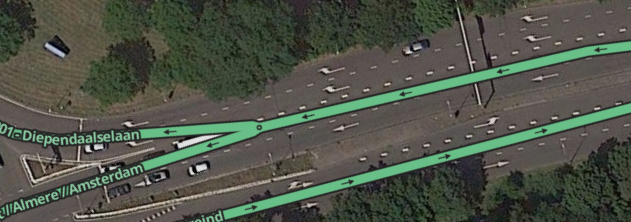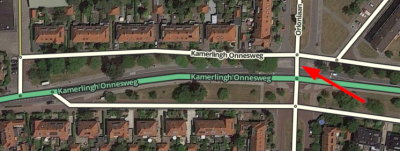mNo edit summary |
m (Turned bold titles into 4th level headers to make page links work) |
||
| (5 intermediate revisions by 2 users not shown) | |||
| Line 11: | Line 11: | ||
* Page on [[Locks|Lock level]]. | * Page on [[Locks|Lock level]]. | ||
* Page on [[Nodes]]. | * Page on [[Nodes]]. | ||
==== Unpaved ==== | |||
Check the <i>Unpaved</i> attribute for | Check the <i>Unpaved</i> attribute when it may be uncomfortable for some drivers to be routed via an unpaved or degraded road.<br /> | ||
The [[Waze app|app]] has a setting for using Unpaved roads. The default is "Don't allow". Other values are "Allow" and "Avoid long ones". <br /> | The [[Waze app|app]] has a setting for using Unpaved roads. The default is "Don't allow". Other values are "Allow" and "Avoid long ones". <br /> | ||
Do not use that attribute when a road is only driveable by a 4x4: see the description of the [[Off-road]] road type.<br /> | |||
We have observed that Waze disregards the "unpaved" setting in the app when the destination is on an "unpaved" segment. Hence, avoid making as unpaved a segment having destination, unless strictly necessary. | |||
==== Minimum segment length ==== | |||
A segment should not be shorter than 6 meters. Everything smaller than 15m is nearly invisible in the app.<br /> | A segment should not be shorter than 6 meters. Everything smaller than 15m is nearly invisible in the app.<br /> | ||
==== Headlights required ==== | |||
The ''headlight warning'' is given each time in the [[Waze app|app]] when a route is started that passes a segment with ''Headlight required'' checked. This warning only makes sense in the few countries for which this warning was developed. Better leave this attribute unchecked. | The ''headlight warning'' is given each time in the [[Waze app|app]] when a route is started that passes a segment with ''Headlight required'' checked. This warning only makes sense in the few countries for which this warning was developed. Better leave this attribute unchecked. | ||
==== Next to a carpool/bus lane ==== | |||
Select this attribute on a segment when it is immediately adjacent to a carpool or bus lane segment. Do not use this attribute on the carpool or bus lane segments themselves. | |||
By checking this feature, GPS deviations are taken into account when calculating the arrival time. GPS drift can cause speed information to be assigned to the wrong (adjacent) segment. | |||
<!--T:2--> | <!--T:2--> | ||
==== Average Speed Cameras ==== | |||
[[File:Average-speed-camera.png|right]]Check on all road segments where average speed cameras are operational the Average Speed Camera check boxes. If a ASC zone starts or ends in the middle of an existing (longer) segment, you may have to add a new node ([[Additional editing tips|by splitting the segment]]), to get the ASC notifications to start / end at the correct locations. If the start/end is approximately 20m from an existing node, this is not necessary.<br /> | [[File:Average-speed-camera.png|right]]Check on all road segments where average speed cameras are operational the Average Speed Camera check boxes. If a ASC zone starts or ends in the middle of an existing (longer) segment, you may have to add a new node ([[Additional editing tips|by splitting the segment]]), to get the ASC notifications to start / end at the correct locations. If the start/end is approximately 20m from an existing node, this is not necessary.<br /> | ||
If the cameras are already placed but not yet operational use [[Camera#False_Camera|dummy camera's]].<br /> | If the cameras are already placed but not yet operational use [[Camera#False_Camera|dummy camera's]].<br /> | ||
<!--T:5--> | <!--T:5--> | ||
<small>Currently , due to a bug, a <i>Average speed control</i> should always start at the A point of a segment. In case of a two way <i>average speed control</i> it may be necessary to split a segment in two parts, change the A and B points of the newly created segment with as result that from both ways the <i>average speed control</i> can be defined on a segment starting with an A point. The A-point triggers the warning message.</small><br /> | <small>Currently, due to a bug, a <i>Average speed control</i> should always start at the A point of a segment. In case of a two way <i>average speed control</i> it may be necessary to split a segment in two parts, change the A and B points of the newly created segment with as result that from both ways the <i>average speed control</i> can be defined on a segment starting with an A point. The A-point triggers the warning message.</small><br /> | ||
<br /> | <br /> | ||
Latest revision as of 11:36, 4 February 2024

Segment Properties
Properties relevant for most Road typesː
- Page on Street and City names.
- Page on Speed limit.
- Page on House numbers.
- Page on New Housing Development.
- Page on Elevation.
- Page on Lock level.
- Page on Nodes.
Unpaved
Check the Unpaved attribute when it may be uncomfortable for some drivers to be routed via an unpaved or degraded road.
The app has a setting for using Unpaved roads. The default is "Don't allow". Other values are "Allow" and "Avoid long ones".
Do not use that attribute when a road is only driveable by a 4x4: see the description of the Off-road road type.
We have observed that Waze disregards the "unpaved" setting in the app when the destination is on an "unpaved" segment. Hence, avoid making as unpaved a segment having destination, unless strictly necessary.
Minimum segment length
A segment should not be shorter than 6 meters. Everything smaller than 15m is nearly invisible in the app.
Headlights required
The headlight warning is given each time in the app when a route is started that passes a segment with Headlight required checked. This warning only makes sense in the few countries for which this warning was developed. Better leave this attribute unchecked.
Next to a carpool/bus lane
Select this attribute on a segment when it is immediately adjacent to a carpool or bus lane segment. Do not use this attribute on the carpool or bus lane segments themselves. By checking this feature, GPS deviations are taken into account when calculating the arrival time. GPS drift can cause speed information to be assigned to the wrong (adjacent) segment.
Average Speed Cameras

Check on all road segments where average speed cameras are operational the Average Speed Camera check boxes. If a ASC zone starts or ends in the middle of an existing (longer) segment, you may have to add a new node (by splitting the segment), to get the ASC notifications to start / end at the correct locations. If the start/end is approximately 20m from an existing node, this is not necessary.
If the cameras are already placed but not yet operational use dummy camera's.
Currently, due to a bug, a Average speed control should always start at the A point of a segment. In case of a two way average speed control it may be necessary to split a segment in two parts, change the A and B points of the newly created segment with as result that from both ways the average speed control can be defined on a segment starting with an A point. The A-point triggers the warning message.
Aspects
- Page on Junction Arrows
- Page on Junction Box
Keep It Simple/Stupid (KISS)
"As simple as possible, as complex as necessary"
KISS is keeping the road geometry as simple as possible, without losing the essential driving instructions.
More info, see the KISS page.
Filter lanes

Filter lanes are not mapped.
Filter lanes don't fit the KISS principle because they are the cause of very complex situations that are hard to manage, while they don't add a lot of value in most routing instructions. Short segments and extra splits can have a negative influence on routing (extra penalty, incorrect average speeds, ...).
Of course, there is always an exception. If the choice of a filter lane must be made more than 50 meter before coming to the crossing AND the main road and filter lane are divided by obstacles (concrete blocks, ...), it should be mapped.
Ring roads
There are roads that could be classified by multiple street types. We think of ring roads (R-roads) which sometimes can also be a N-road categorized as Major Highway. For example, the ring road of Leuven, the R23, has long segments which are also N2 or N3. In these cases we categorize the ring road as Major Highway.
Ring roads which are also freeways, like the R0 of Brussels, are categorized as Freeway.
Roundabouts
If you want to add a Roundabout, you firstly draw the roads as a normal crossroad, but don't connect the roads/segments. Secondly you draw the Roundabout and WME will connect the crossing roads automatically.
A Roundabout must always get a city name but never a streetname. The reason for this has to do with the navigation instructions and road announcements. A Roundabout always gets categorized as the type of the passing through road.
See the Roundabout page.
Shopping streets
Shopping streets only allowed for pedestrians (and cyclists) with the exception of certain hours loading/unloading, are defined as Non-drivable roads.
Double left and double right

The Waze routing algorithm prevents double-left or double-right turns by using an extremely large U-turn penalty when these conditions are met:
- Three segments: The U-turn is a reversal of driving direction through three segments: an incoming segment (A), a single median segment (B) and an outgoing segment (C).
- Short median: The median segment (B) is shorter than or equal to 15 meters.
- In/out parallelism: The in and out segments (A and C) are within ±5° of parallel to each other. If the median segment isn't straight calculate the degrees as if an imaginary straight segment was connectining the A and C segments.
- Not all the A, B and C segments are Street. In other words: 1 of the parallel segment is PS or higher.
- The two nodes interconnecting A, B and C are not in a Junction Box.
Example / see picture: Driving from left to right on the top street (A) with destination towards the east requires a reversal of driving direction. When the median segment B (red arrow) is 15 meters or less the app will navigate over the lower street towards the east. Only if this median segment is 16 meters or more the app will navigate over the bigger road in the middle (C).
It is possible for this method to fail to prevent a U-turn when it is the first segment of a route, or it immediately follows a reroute.
See also the global page on Routing penalties/Controlling U-turn penalties